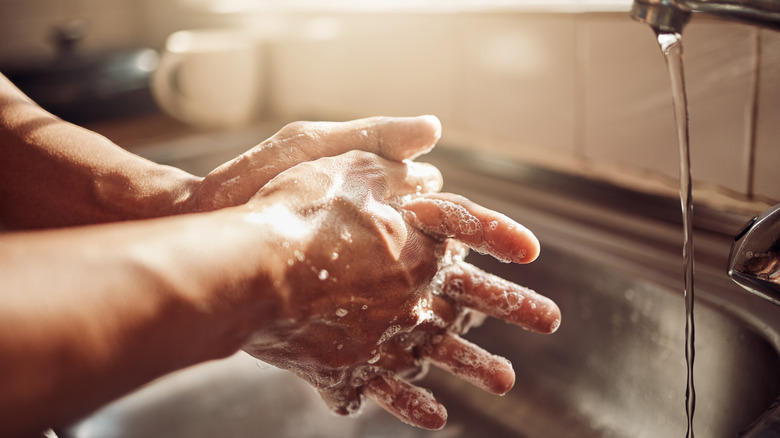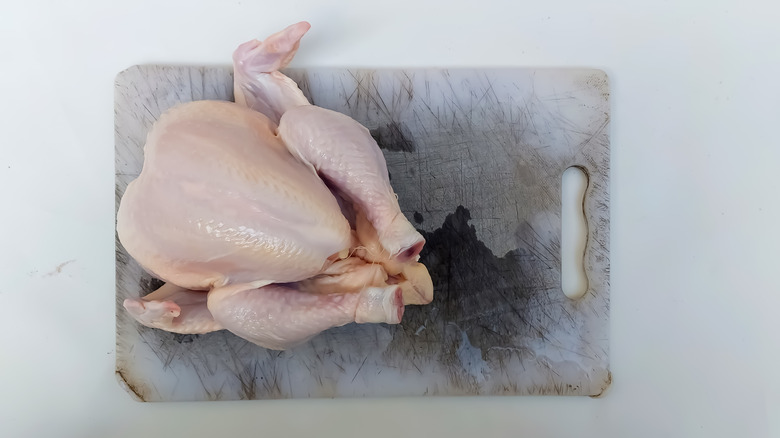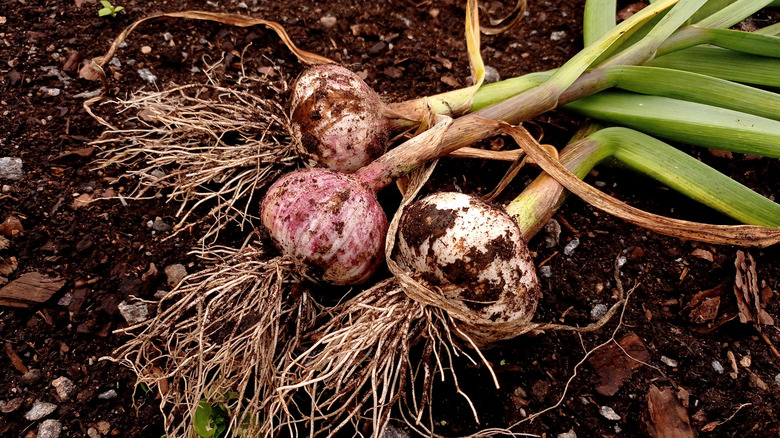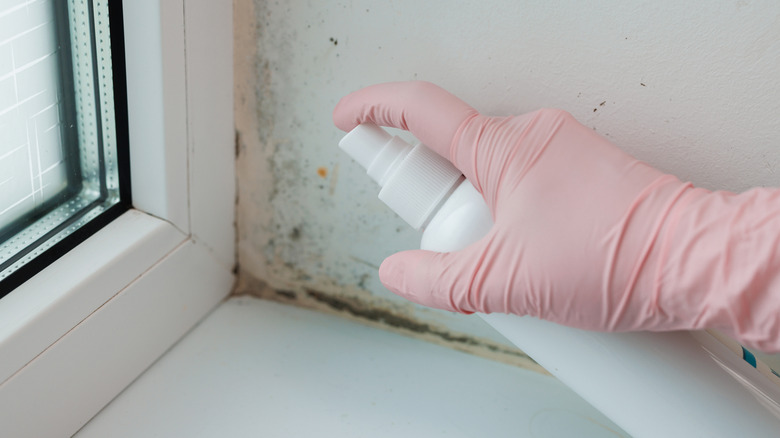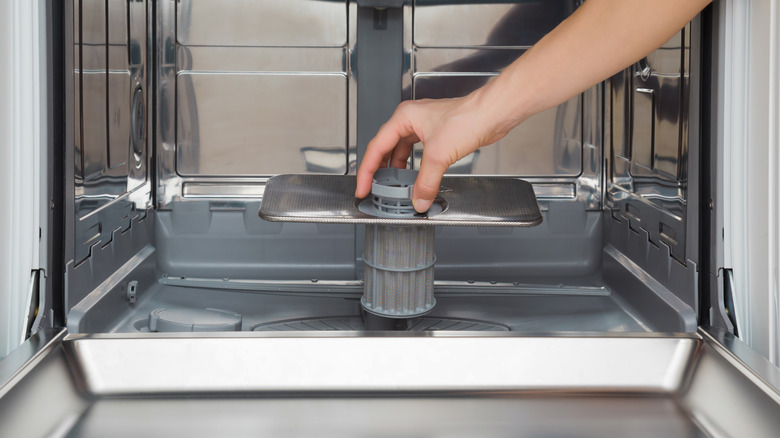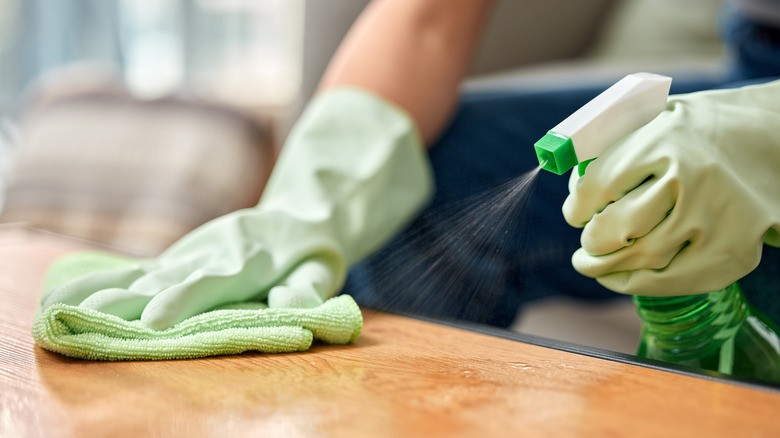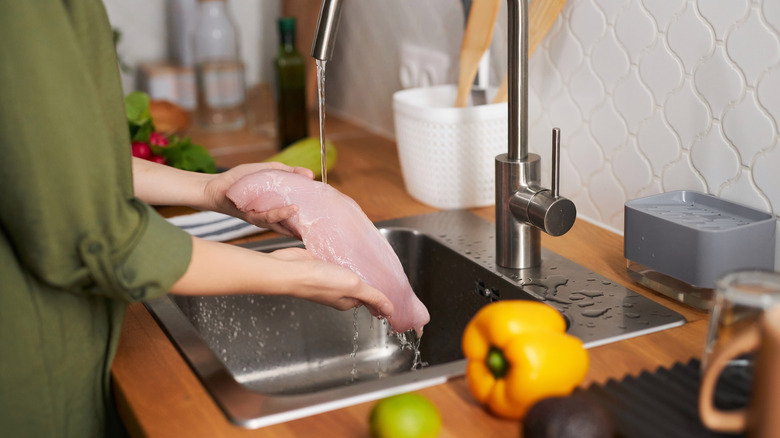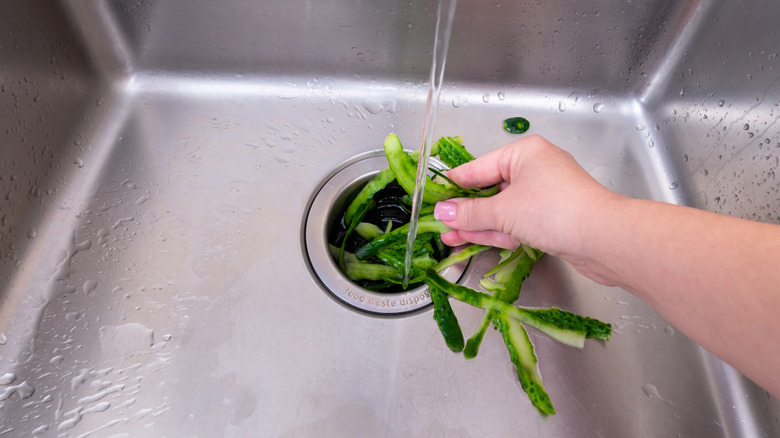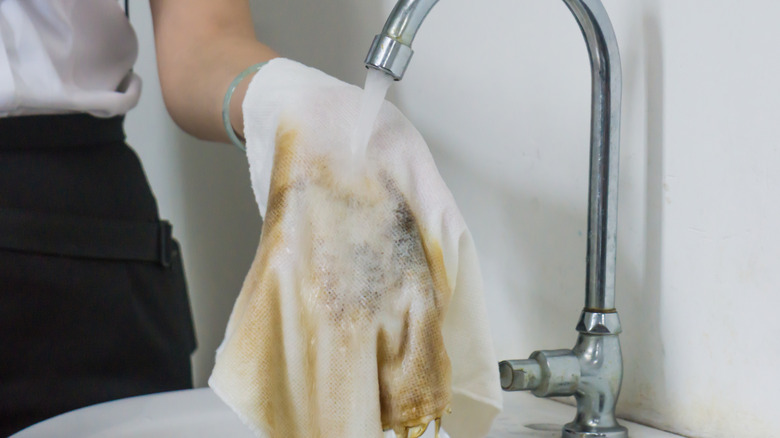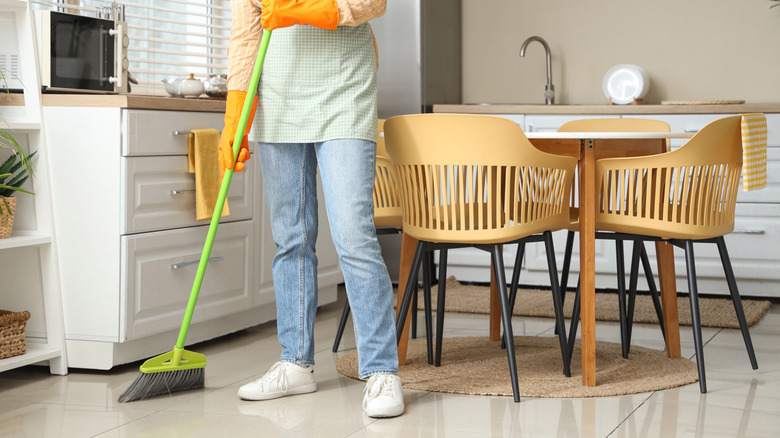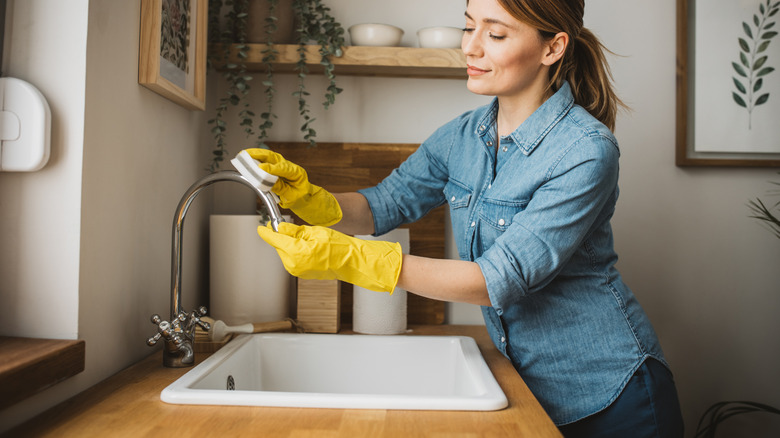12 Kitchen Sanitation Mistakes You Need To Stop Making
As someone who has spent years in all types of food service operations, from college dining halls to historic seafood restaurants to local coffee shops, and is certified in food safety, I've worked in and around my fair share of kitchens and picked up a good deal of food safety knowledge. When you're working at a dining hall that exclusively sells made-from-scratch chicken tenders, you're bound to learn a thing or two about how to prevent cross-contamination and avoid getting the whole campus sick.
Luckily, everywhere I've worked has had wonderfully thorough and safe systems. I've learned so much from each position, not to mention receiving my food safety certification that broke down all the information explaining why we use each science-backed method. Not that it didn't make sense why we would sanitize surfaces after we used them or washed both sides of the cutting board, but I like knowing why I do the things I'm instructed to do. So, here are my biggest takeaways for the main kitchen sanitation mistakes you might be making, and how to prevent them. I'll give you a hint: You'll find many uses for that white vinegar in your pantry.
Not washing your hands
Every — and yes, I mean every — time you touch raw meat, eggs, fish, or poultry, you need to wash your hands with warm water and soap for at least 20 seconds. I'm sure most of us have done the little fingertip rinse after cracking eggs for that quick breakfast when we're in a rush, but really, to prevent the spreading of germs and foodborne illnesses, the full 20 seconds is important. This matters even more when cooking for young children, older guests, or anyone immunocompromised. The egg rinse might suit you for now if you're healthy. However, anyone with a weakened immune system could be more susceptible to foodborne illness, and we don't want to accidentally get our friends or family sick!
Personally, I've thought so much about bacteria and food contamination through all my work and personal experiences that this has become an instinct. Plus, half of the raw things we touch make our hands a little bit sticky (I'm looking at you, raw chicken), and I hate cooking with sticky fingers. If you forget that you've touched something raw and then go grabbing a bunch of spices, the butter dish, the pepper grinder, and opening cabinets, all those things now need to be sanitized too, because any guests or family members could unknowingly open that cabinet or crank that pepper and come in contact with these harmful bacteria. Seriously, it's less trouble to wash your hands, I promise.
Reusing cutting boards
Now, if you're chopping veggies for a tasty summer pasta salad, reusing that cutting board for the tomatoes and cucumbers is no biggie. But if raw meat or eggshells come into contact with your cutting board, fully wash and dry it before you can begin cutting produce, cheese, or anything else that will be served fresh. And don't forget to wash the knife (including the handle)! This step is crucial, and as simple as it may sound, I've seen plenty of newbies make the eggshell mistake.
I also always recommend washing both sides of the cutting board, as opposed to just the one that you've cut on. This is because there could have been juices or egg whites dripping off the side of the cutting board, and coming into contact with the countertop and spreading underneath. Even if you don't see this happening, it never hurts to be safe and keep yourself or someone else from potentially getting sick. Plus, if you've been cutting raw meat and touching the cutting board with your hands, chances are those bacteria have gotten on the rim and surrounding counter.
Not washing produce
A good rinse to get any lingering dirt off your mushrooms, beets, or lettuce, and a quick scrub on your potatoes or yams is a good idea to eliminate some of that earthy flavor and keep that soil out of your dinner. But some produce should also be washed with a fruit and veggie wash before it's safe to eat. This is especially important with non-organic produce, which is sprayed with pesticides to deter insects and increase the quantity of food produced.
Some of these pesticides can cause health issues for humans, too. And some fruits and vegetables need more careful attention than others due to the quantity and type of pesticides used. Some of the major culprits are non-organic strawberries, spinach, kale, apples, and bell peppers. Not to mention, you've been to the produce aisle, you've seen how just anybody can touch as many cucumbers, bell peppers, or heads of cabbage as they want until they find their favorite one, and there's no telling where their hands have been. Be sure their germs stay out of your mouth. Wash your produce.
Neglecting the sponge
Whether you use the classic yellow and green sponge, the durable Scrub Daddy, or a bamboo scrub brush (which I recommend), it's important to remember that all of these handy tools are hotbeds for bacteria. They sit wet almost all the time and come into contact with all kinds of foods. It's a microbe paradise. Yeasts, molds, and bacteria begin to accumulate from the first time you use your sponge. Luckily, there are ways to sanitize these kitchen essentials.
A study by the USDA showed that microwaving was the most effective way to kill bacteria on sponges, and running them through the dishwasher was the most effective way to kill yeasts and molds. Both methods were incredibly effective compared to other methods tested. So don't worry, you don't have to replace them every Friday or bust out the bleach solution to sanitize them. Add disinfecting them to your weekly kitchen routine! If you have the bamboo scrubber, you can boil it for a few minutes as needed, and I throw mine in the oven at a very low temperature to make sure that it dries completely, but this isn't necessary. Most brands suggest using the same scrubber for months if you take care of it!
Skipping the nooks and crannies
It's great to give those countertops a quick wipe down after you've made dinner, but don't forget the corners, seams, and any pesky little crevices bacteria could hide. The rim of the sink, around the faucet, around the stove, and beneath your movable countertop appliances are all places where crumbs, grease, and bacteria all like to hide. Not only could the microbes build up, but the food bits and pieces can eventually start to cause a lingering odor in your otherwise clean kitchen.
I even suggest wiping down things like the handle to the air fryer and oven, the face of the microwave, fridge, and freezer handles, and the handles to your cabinets and drawers, as they are all high-contact places where grime, grease, and bacteria can build up and spread between people in your home. Oh, and don't forget the handles to your faucet and the detachable head if your sink has one (bacteria love water), and these are some of the most frequently touched appliances in the home.
Ignoring the inside of the dishwasher
This is one of those things that could totally go unnoticed by new homeowners or renters until it starts to cause a problem. Many people don't know that you need to clean out the filter at the bottom of your dishwasher regularly, or that there are some mistakes you might be making when loading your dishwasher that leave you with dirtier dishes and a smelly dishwasher. Most dishwashers have a removable filter that you can take out and scrub. We recommend soaking the filter in hot water and dish soap and scrubbing with a bristled brush, like a toothbrush or bamboo scrubber.
For a deeper clean, you can get down into the drain beneath your dishwasher and clean with a two-step vinegar and baking soda process. A vinegar cleaning is super helpful for odors, grease, and mineral buildup, and is pretty simple. Just fill a bowl with vinegar and place it face-up on the top shelf of your empty dishwasher. Then set your dishwasher to the hottest setting and run a wash cycle. You can skip the drying because you're going to follow up with the baking soda. Sprinkle a cup of baking soda on the bottom floor of the dishwasher, and run a short, hot cycle. This will be incredibly helpful for lingering odors and both steps will get a good clean on that freshly scrubbed filter.
Not matching your cleaning products to your countertop material
Some chemicals, like bleach, ammonia, and vinegar, are not to be used on certain countertops, like granite and quartz. An abrasive brillo pad can even scratch these surfaces, dull their shine, and weaken the resin bonds that hold the seams together to keep them air and watertight. Cleaners with strong acids in them can damage laminate countertops, too. For most general messes, a good hot soapy water scrub, rinse, and dry will do the cleaning part. To sanitize, you can follow up with a simple disinfectant.
The type of disinfectant you should use depends on what material your countertop is made of. As there are tons of options for stone countertops, be sure to double-check what material yours is made of if you're not sure. For granite and quartz, a mixture of at least 70% isopropyl alcohol and water will do the trick, disinfecting but not doing anything to damage your surfaces. And don't worry, the smell will dissipate if open a window before it gets too strong. For laminate or formica countertops, you can use your preferred disinfecting spray, like Clorox or Lysol. But remember what I said about the abrasion, no brillo pads or steel wool! If you've got a mess that's just really stuck on there, let it soak in hot soapy water for 10 to 15 minutes and revisit it.
Washing raw poultry
This is one mistake I wish I could scream a warning about from the rooftops. It's not only unnecessary to rinse raw poultry, meat, or fish, but the practice is a major spreader of harmful bacteria that cause foodborne illness. While you're rinsing that chicken in your sink, now your whole sink (plus any dishes) and everything in the splatter zone could be contaminated with bacteria from the droplets splashing off of the raw meat. This means you now have to sanitize the faucets, counters around your sink, the entire sink, any soap bottles sitting on the rim, and your own arms at least up to the elbow.
I don't even want to think about the shirt or apron you're wearing, but you should go ahead and change those too after you sanitize everything else. Overall, this step is wholly unnecessary and poses unnecessary risks to everyone's health. If this is your go-to method, I recommend reading up on other meat food safety mistakes and how to avoid them to keep you, your family, and your friends safe and healthy!
Forgetting the garbage disposal
The handy garbage disposal is truly a gift of convenience to any kitchen. But it needs proper care of, too, especially if you rarely use it. I know that may sound counterintuitive, but when those blades down in the drain sit still, they catch tiny food particles that slip through your drain catcher. Things can get trapped in there even when you use it regularly, so cleaning is always important to prevent odors and damage to the blades. It's even more important when they don't get used as often.
To freshen up this appliance, start by boiling a pot of water and sending it down the drain to dislodge those food particles. You can briefly turn it on while doing this to help dislodge that debris. After this, do the classic baking soda and vinegar method. A half cup of baking soda and a cup of vinegar should do the trick. Let that sit for about 10 to 15 minutes and then rinse with more hot water. Some people also like to do a bit of ice and lemon peels for a cold scrub and smell combo, but this can have adverse effects on the lifetime of those blades.
Overusing the same towels
While I totally, 1000% recommend getting yourself a set of good, cotton, textured kitchen towels beyond the cute decorative ones, they require regular washing. This type of towel keeps your paper towel usage way down (or eliminates it), allowing you to clean with it instead of quickly drying your hands on the decorative one that doesn't absorb any of the water. These towels are great for wiping messes, drying the counters after washing, drying dishes, and tons of other uses. But it's important to remember what's what, and how long you've been using it. You don't want to dry your hands or your fruit bowl on the towel you just used to wipe up a sauce spill!
I recommend keeping in-use towels at different locations in the kitchen to never confuse the dish-drying towel for the mess-wiping one. Keeping a basket for dirty kitchen towels under the sink is another great way to keep everything organized and those dirty kitchen towels from accidentally getting washed with your undergarments or favorite white t-shirt. There are plenty of ways to store your kitchen towels while saving space, so you don't have to worry about emptying a whole cabinet.
Not cleaning top-to-bottom
Personally, this is one of the most helpful and practical pieces of advice I've learned through all of my culinary experiences. It's intuitive enough, but implementing this as a rule has saved me so much time and effort. It just means that you should start cleaning the things in your kitchen that are the highest up and work your way down to the floor.
No, this doesn't mean you need to wipe down the cabinets and ceiling every time you clean the kitchen, but simply that if the highest thing in your kitchen is the stovetop, counters, or top of the microwave, start there, so any crumbs, dust, or debris you brush off will get cleaned up in your next step. Otherwise, if you start by sweeping the floor and then later wipe the counters down, all those rogue crumbs are now on your freshly swept floor!
Not disinfecting faucets
This is a totally easy one to forget about, or maybe it never crossed your mind at all, quite frankly. I always cleaned around the faucets to prevent any grime or buildup, but it scarcely crossed my mind to clean the faucet head until I noticed the calcium buildup was affecting the water stream. To clean a kitchen faucet, you can start by soaking the head in a baggie filled with vinegar and attached with a rubber band to loosen any debris and mineral buildup.
In some faucets, you can remove and scrub the head and aerator, but check to see what type of faucet you have and if this is recommended before taking things apart. You can scrub and soak these features as well if they have accumulated buildup, and then use a disinfectant that is safe for whatever material your faucet is made of or coated in to finish the process before giving everything a good rinse and repeating the soaking method from before but now with fresh clean water to remove any last debris and the remnants of the disinfectant.

